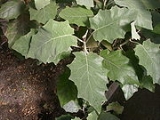
Brachyglottis repanda
Encyclopedia
Rangiora or Bushman's friend (Brachyglottis repanda) is a small, bushy tree or tall shrub endemic
to New Zealand
. It grows to a height of 5 to 7 metres. The large leaves
with a soft furry underside have been referred to as "Bushman's toilet paper".
Although it has a single English vernacular name, in Māori it is variably known as Kōuaha, Pukapuka, Pukariao, Puke-rangiora, Rangiora, Raurākau, Raurēkau, Whārangi, or Whārangi-tawhito.
There is also a town in the South Island
called Rangiora. The New Zealand Plant Website http://www.bushmansfriend.co.nz/ and related tourist organisation in Whangaroa
are named after the plant.
Māori used the plant for a number of medicinal uses. The leaves were used for wounds and old ulcerated sores, and the gum was chewed for foul breath but was poisonous if swallowed.
It can also be used as note paper.
Endemic (ecology)
Endemism is the ecological state of being unique to a defined geographic location, such as an island, nation or other defined zone, or habitat type; organisms that are indigenous to a place are not endemic to it if they are also found elsewhere. For example, all species of lemur are endemic to the...
to New Zealand
New Zealand
New Zealand is an island country in the south-western Pacific Ocean comprising two main landmasses and numerous smaller islands. The country is situated some east of Australia across the Tasman Sea, and roughly south of the Pacific island nations of New Caledonia, Fiji, and Tonga...
. It grows to a height of 5 to 7 metres. The large leaves
Leaf
A leaf is an organ of a vascular plant, as defined in botanical terms, and in particular in plant morphology. Foliage is a mass noun that refers to leaves as a feature of plants....
with a soft furry underside have been referred to as "Bushman's toilet paper".
Although it has a single English vernacular name, in Māori it is variably known as Kōuaha, Pukapuka, Pukariao, Puke-rangiora, Rangiora, Raurākau, Raurēkau, Whārangi, or Whārangi-tawhito.
There is also a town in the South Island
South Island
The South Island is the larger of the two major islands of New Zealand, the other being the more populous North Island. It is bordered to the north by Cook Strait, to the west by the Tasman Sea, to the south and east by the Pacific Ocean...
called Rangiora. The New Zealand Plant Website http://www.bushmansfriend.co.nz/ and related tourist organisation in Whangaroa
Whangaroa
Whangaroa is a locality on the harbour of the same name in Northland, New Zealand.Whangaroa is 8km north-west from Kaeo and 45km north from Okaihau. The harbour is almost landlocked and is popular both as a fishing spot in its own right and as a base for deep-sea fishing.The harbour was the scene...
are named after the plant.
Māori used the plant for a number of medicinal uses. The leaves were used for wounds and old ulcerated sores, and the gum was chewed for foul breath but was poisonous if swallowed.
It can also be used as note paper.

